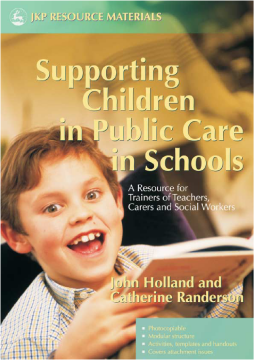
Additional Information
Book Details
Abstract
Supporting Children in Public Care in Schools is a training package designed for delivery to teachers, social workers, carers and all those supporting young people who are in public care.
Based on collaborative multi-agency and multi-professional work with psychologists, teachers and social workers, Supporting Children in Public Care in Schools focuses on the different types of loss that children in care may experience as a result of significant changes in placement, such as the loss of family, friends, routine and the familiar school environment. The training pack includes photocopiable material and instructions for more than a dozen training sessions. These address a range of issues including why young people are in care, how feelings of loss relate to the experience of being in care and how being in care may affect education, attainment and emotional attachment. There is a focus on making any necessary school transitions work effectively in order to provide educational stability in a young person's life. The authors realise that the transition into school is a key event, so it is crucial that it is carefully planned, that there is a positive welcoming ethos and that there is effective communication within the school.
The flexible modular structure of this resource means that sessions can be planned around trainee's needs and can be delivered as single topics if required. Each training module includes group activities, templates for OHP transparencies, handouts for trainees and a bibliography.
This much-needed training package raises awareness of the experiences of young people in public care and provides essential guidance for staff in schools or other settings on how to assist young people through corporate parenting, smooth transitions into school, designated teachers and personal education plans.
John Holland is a chartered educational psychologist with a senior practitioner role in parenting with North Yorkshire County Council. John also has an independent private practice, including being a trainer and consultant in the area of children, bereavement and loss, this after previous roles in education as a special educational needs peripatetic teacher and as an infant teacher and special needs coordinator in schools.
Catherine Randerson assesses young people with emotional and psychological difficulties with the Interagency Link Team in Hull. She previously worked as a teacher's aide and education welfare officer.
It's an excellent resource for busy trainers who might like a pack with everything at hand including templates for OHPs and guidance notes for facilitators, plus photocopy material for handouts'.
News@www.adoption-net.co.uk
If you're looking for a compact, off-the-peg training pack suitable for the main players in supporting the education of looked-after children, this is it, writes Simon Colbeck. One slim volume contains pages for copying as handouts and OHP transparencies as well as guidance on presenting the material in 17 concise sections. These could be delivered in a single day. Particularly helpful is the way the sections encourage participants to develop each others and their own roles on the shared aims deriving from the title... The book would be as useful to an enthusiastic practitioner as a specialist trainer.
Community Care
Table of Contents
| Section Title | Page | Action | Price |
|---|---|---|---|
| Foreword | |||
| Acknowledgements | |||
| What is Sphere? | |||
| 1. The Handbook | |||
| 2. Using the Standards in context | |||
| Appendix 1 Delivering assistance through markets | |||
| The Humanitarian Charter | |||
| Protection Principles | |||
| The Core Humanitarian Standard on Quality and Accountability | |||
| Water, Sanitation and Hygiene Promotion (WASH) | |||
| Food Security and Nutrition | |||
| Shelter and Settlement | |||
| Health | |||
| Annexes | |||
| Annex 1 Legal foundation to Sphere | |||
| Annex 2 The Code of Conduct for the International Red Cross and Red Crescent Movement and Non-Governmental Organisations (NGOs) in Disaster Relief | |||
| Annex 3 Abbreviations and acronyms | |||
| Index |
